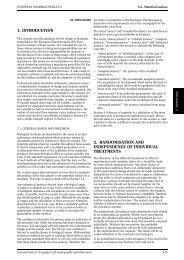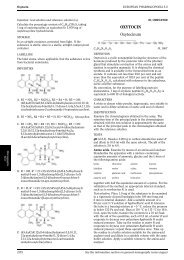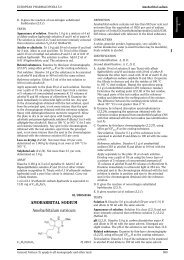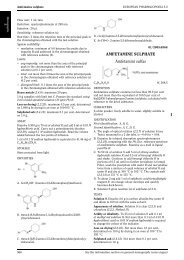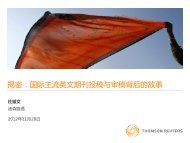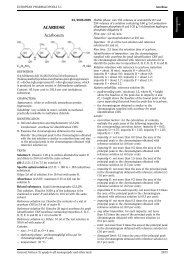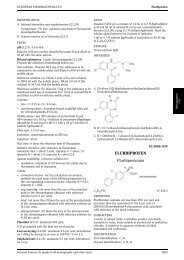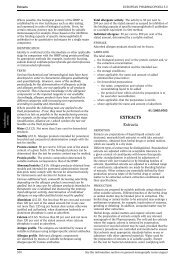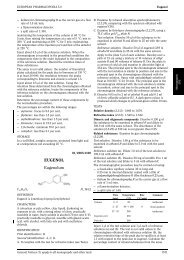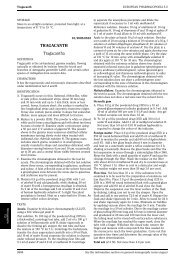SODIUM BROMIDE Natrii bromidum SODIUM CALCIUM EDETATE ...
SODIUM BROMIDE Natrii bromidum SODIUM CALCIUM EDETATE ...
SODIUM BROMIDE Natrii bromidum SODIUM CALCIUM EDETATE ...
Create successful ePaper yourself
Turn your PDF publications into a flip-book with our unique Google optimized e-Paper software.
Sodium bromide EUROPEAN PHARMACOPOEIA 5.0<br />
solution C using the solution obtained with 10 ml of water R<br />
as the compensation liquid. The absorbance of solution A is<br />
not greater than that of solution C (300 ppm).<br />
Heavy metals (2.4.8). 2.0 g complies with limit test C for<br />
heavy metals (10 ppm). Prepare the standard using 2 ml of<br />
lead standard solution (10 ppm Pb) R.<br />
Loss on drying (2.2.32). Not more than 2.0 per cent,<br />
determinedon1.00gbydryinginanovenat100°Cto<br />
105 °C.<br />
ASSAY<br />
Dissolve 0.250 g in 20 ml of anhydrous acetic acid R,<br />
heating to 50 °C if necessary. Cool. Using 0.05 ml of<br />
naphtholbenzein solution R as indicator, titrate with 0.1 M<br />
perchloric acid until a green colour is obtained.<br />
1mlof0.1Mperchloric acid is equivalent to 14.41 mg of<br />
C7H5NaO2. <strong>SODIUM</strong> <strong>BROMIDE</strong><br />
<strong>Natrii</strong> <strong>bromidum</strong><br />
01/2005:0190<br />
Iodides. To 5 ml of solution S add 0.15 ml of ferric chloride<br />
solution R1 and 2 ml of methylene chloride R. Shakeand<br />
allow to separate. The lower layer is colourless (2.2.2,<br />
Method I).<br />
Sulphates (2.4.13): maximum 100 ppm.<br />
15 ml of solution S complies with the limit test for sulphates.<br />
Iron (2.4.9): maximum20ppm. 5 ml of solution S diluted to 10 ml with water R complies<br />
with the limit test for iron.<br />
Magnesium and alkaline-earth metals (2.4.7): maximum<br />
200 ppm, calculated as Ca.<br />
10.0 g complies with the limit test for magnesium and<br />
alkaline-earth metals. The volume of 0.01 M sodium edetate<br />
used does not exceed 5.0 ml.<br />
Heavy metals (2.4.8): maximum 10 ppm.<br />
12 ml of solution S complies with limit test A. Prepare the<br />
standard using lead standard solution (1 ppm Pb) R.<br />
Loss on drying (2.2.32): maximum 3.0 per cent, determined<br />
on 1.000 g by drying in an oven at 100-105 °C for 3 h.<br />
ASSAY<br />
Dissolve 2.000 g in water R and dilute to 100.0 ml with<br />
thesamesolvent.To10.0mlofthesolutionadd50mlof<br />
water R, 5mlofdilute nitric acid R, 25.0mlof0.1 M silver<br />
nitrate and 2 ml of dibutyl phthalate R. Shake.Titrate<br />
with 0.1 M ammonium thiocyanate, using2mlofferric<br />
ammonium sulphate solution R2 as indicator and shaking<br />
vigorously towards the end-point.<br />
1mlof0.1 M silver nitrate is equivalent to 10.29 mg of NaBr.<br />
Calculate the percentage content of NaBr from the<br />
expression:<br />
NaBr<br />
DEFINITION<br />
Mr 102.9<br />
Content: 98.0 per cent to 100.5 per cent (dried substance).<br />
CHARACTERS<br />
Appearance: white,granularpowderorsmall,colourless,<br />
transparent or opaque crystals, slightly hygroscopic.<br />
Solubility: freely soluble in water, soluble in alcohol.<br />
IDENTIFICATION<br />
A. It gives reaction (a) of bromides (2.3.1).<br />
a = percentage content of NaBr and NaCl obtained in<br />
B. Solution S (see Tests) gives the reactions of sodium<br />
the assay and calculated as NaBr,<br />
(2.3.1).<br />
b = percentage content of Cl in the test for chlorides.<br />
TESTS<br />
Solution S. Dissolve 10.0 g in carbon dioxide-free water R<br />
prepared from distilled water R and dilute to 100 ml with<br />
the same solvent.<br />
STORAGE<br />
In an airtight container.<br />
Appearance of solution. Solution S is clear (2.2.1) and<br />
01/2005:0231<br />
colourless (2.2.2, Method II).<br />
Acidity or alkalinity. To 10 ml of solution S add 0.1 ml of <strong>SODIUM</strong> <strong>CALCIUM</strong> <strong>EDETATE</strong><br />
bromothymol blue solution R1. Notmorethan0.5mlof<br />
0.01 M hydrochloric acid or 0.01 M sodium hydroxide is<br />
required to change the colour of the indicator.<br />
Bromates. To 10 ml of solution S add 1 ml of starch<br />
solution R, 0.1 ml of a 100 g/l solution of potassium<br />
iodide R and 0.25 ml of 0.5 M sulphuric acid and allow to<br />
stand protected from light for 5 min. No blue or violet colour<br />
develops.<br />
<strong>Natrii</strong> calcii edetas<br />
Chlorides: maximum 0.6 per cent.<br />
C10H12CaN2Na2O8,xH2O Mr 374.3 (anhydrous substance)<br />
In a conical flask, dissolve 1.000 g in 20 ml of dilute nitric<br />
acid R. Add 5 ml of strong hydrogen peroxide solution R<br />
and heat on a water-bath until the solution is completely<br />
decolourised. Wash down the sides of the flask with a little<br />
water R and heat on a water-bath for 15 min. Allow to cool,<br />
dilute to 50 ml with water R and add 5.0 ml of 0.1 M silver<br />
DEFINITION<br />
Disodium [(ethylenedinitrilo)tetraacetato]calciate(2−).<br />
Content: 98.0 per cent to 102.0 per cent (anhydrous<br />
substance).<br />
It contains a variable amount of water of crystallisation.<br />
nitrate and 1 ml of dibutyl phthalate R. Shakeandtitrate<br />
with 0.1 M ammonium thiocyanate, using5mlofferric<br />
ammonium sulphate solution R2 as indicator. Not more<br />
CHARACTERS<br />
Appearance: white or almost white powder, hygroscopic.<br />
than 1.7 ml of 0.1 M silver nitrate is used. Note the volume of Solubility: freely soluble in water, practically insoluble in<br />
0.1 M silver nitrate used (see Assay). Carry out a blank test. alcohol.<br />
2422 See the information section on general monographs (cover pages)
EUROPEAN PHARMACOPOEIA 5.0 Sodium caprylate<br />
IDENTIFICATION<br />
First identification: A, C, D.<br />
Second identification: B, C, D.<br />
A. Infrared absorption spectrophotometry (2.2.24).<br />
Preparation: discs.<br />
Comparison: sodium calcium edetate CRS.<br />
B. Dissolve 2 g in 10 ml of water R, add6mloflead<br />
nitrate solution R, shakeandadd3mlofpotassium<br />
iodide solution R. No yellow precipitate is formed. Make<br />
alkaline to red litmus paper R by the addition of dilute<br />
ammonia R2 and add 3 ml of ammonium oxalate<br />
solution R. A white precipitate is formed.<br />
C. Ignite. The residue gives the reactions of calcium (2.3.1).<br />
D. The residue obtained in identification test C gives the<br />
reactions of sodium (2.3.1).<br />
TESTS<br />
Solution S. Dissolve5.0ginwater R and dilute to 100 ml<br />
withthesamesolvent.<br />
Appearance of solution. Solution S is clear (2.2.1) and<br />
colourless (2.2.2, Method II).<br />
pH (2.2.3): 6.5to8.0. Dissolve 5.0 g in carbon dioxide-free water R and dilute to<br />
25 ml with the same solvent.<br />
Impurity A. Liquid chromatography (2.2.29). Carry out the<br />
test protected from light.<br />
Solvent mixture. Dissolve 10.0 g of ferric sulphate<br />
pentahydrate R in 20 ml of 0.5 M sulphuric acid and add<br />
780 ml of water R. AdjusttopH2.0with1Msodium<br />
hydroxide and dilute to 1000 ml with water R.<br />
Test solution. Dissolve 0.100 g of the substance to be<br />
examined in the solvent mixture and dilute to 25.0 ml with<br />
the solvent mixture.<br />
Reference solution. Dissolve 40.0 mg of nitrilotriacetic<br />
acid R inthesolventmixtureanddiluteto100.0mlwiththe<br />
solvent mixture. To 1.0 ml of the solution add 0.1 ml of the<br />
test solution and dilute to 100.0 ml with the solvent mixture.<br />
Column:<br />
— size: l =0.10m,Ø=4.6mm,<br />
— stationary phase: sphericalgraphitised carbon for<br />
chromatography R1 (5 µm) with a specific surface area of<br />
120 m2 /g and a pore size of 25 nm.<br />
Mobile phase: dissolve 50.0 mg of ferric sulphate<br />
pentahydrate R in 50 ml of 0.5 M sulphuric acid and add<br />
750 ml of water R. AdjusttopH1.5with0.5 M sulphuric<br />
acid or 1 M sodium hydroxide, add20mlofethylene<br />
glycol R and dilute to 1000 ml with water R.<br />
Flow rate: 1ml/min.<br />
Detection: spectrophotometer at 273 nm.<br />
Injection: 20 µl; filter the solutions and inject immediately.<br />
Run time: 4 times the retention time of the iron complex<br />
of impurity A.<br />
Retention time: iron complex of impurity A = about 5 min;<br />
iron complex of edetic acid = about 10 min.<br />
System suitability: reference solution:<br />
— resolution: minimum 7 between the peaks due to the iron<br />
complex of impurity A and the iron complex of edetic acid,<br />
— signal-to-noise ratio: minimum 50 for the peak due to<br />
impurity A.<br />
Limit:<br />
— impurity A: not more than the area of the corresponding<br />
peak in the chromatogram obtained with the reference<br />
solution (0.1 per cent).<br />
Disodium edetate: maximum1.0percent.<br />
Dissolve5.0gin250mlofwater R.Add10mlofammonium<br />
chloride buffer solution pH 10.0 R and about 50 mg of<br />
mordant black 11 triturate R.Notmorethan1.5mlof0.1 M<br />
magnesium chloride is required to change the colour of the<br />
indicator to violet.<br />
Chlorides (2.4.4): maximum 0.1 per cent.<br />
To 20 ml of solution S add 30 ml of dilute nitric acid R,<br />
allow to stand for 30 min and filter. Dilute 2.5 ml of the<br />
filtrate to 15 ml with water R.<br />
Iron (2.4.9): maximum80ppm. Dilute 2.5 ml of solution S to 10 ml with water R. Add 0.25 g<br />
of calcium chloride R to the test solution and the standard<br />
before the addition of the thioglycollic acid R.<br />
Heavy metals (2.4.8): maximum 20 ppm.<br />
1.0gcomplieswithlimittestD.Preparethestandardusing<br />
2mloflead standard solution (10 ppm Pb) R.<br />
Water (2.5.12, Method B): 5.0 per cent to 13.0 per cent,<br />
determined on 0.100 g.<br />
ASSAY<br />
Dissolve 0.300 g in water R and dilute to 300 ml with the<br />
same solvent. Add 2 g of hexamethylenetetramine R and<br />
2mlofdilute hydrochloric acid R. Titratewith0.1 M lead<br />
nitrate, usingabout50mgofxylenol orange triturate R<br />
as indicator.<br />
1mlof0.1 M lead nitrate is equivalent to 37.43 mg<br />
of C10H12CaN2Na2O8. STORAGE<br />
In an airtight container, protected from light.<br />
IMPURITIES<br />
Specified impurities: A.<br />
A. nitrilotriacetic acid.<br />
<strong>SODIUM</strong> CAPRYLATE<br />
<strong>Natrii</strong> caprylas<br />
01/2005:1471<br />
C8H15NaO2 Mr 166.2<br />
DEFINITION<br />
Sodium caprylate contains not less than 99.0 per cent and<br />
not more than the equivalent of 101.0 per cent of sodium<br />
octanoate, calculated with reference to the anhydrous<br />
substance.<br />
CHARACTERS<br />
A white, crystalline powder, very soluble or freely soluble<br />
in water, freely soluble in acetic acid, sparingly soluble in<br />
alcohol, practically insoluble in acetone.<br />
IDENTIFICATION<br />
A. Examine the chromatograms obtained in the test for<br />
related substances. The retention time and size of the<br />
principal peak in the chromatogram obtained with the<br />
GeneralNotices(1)applytoallmonographsandothertexts 2423



